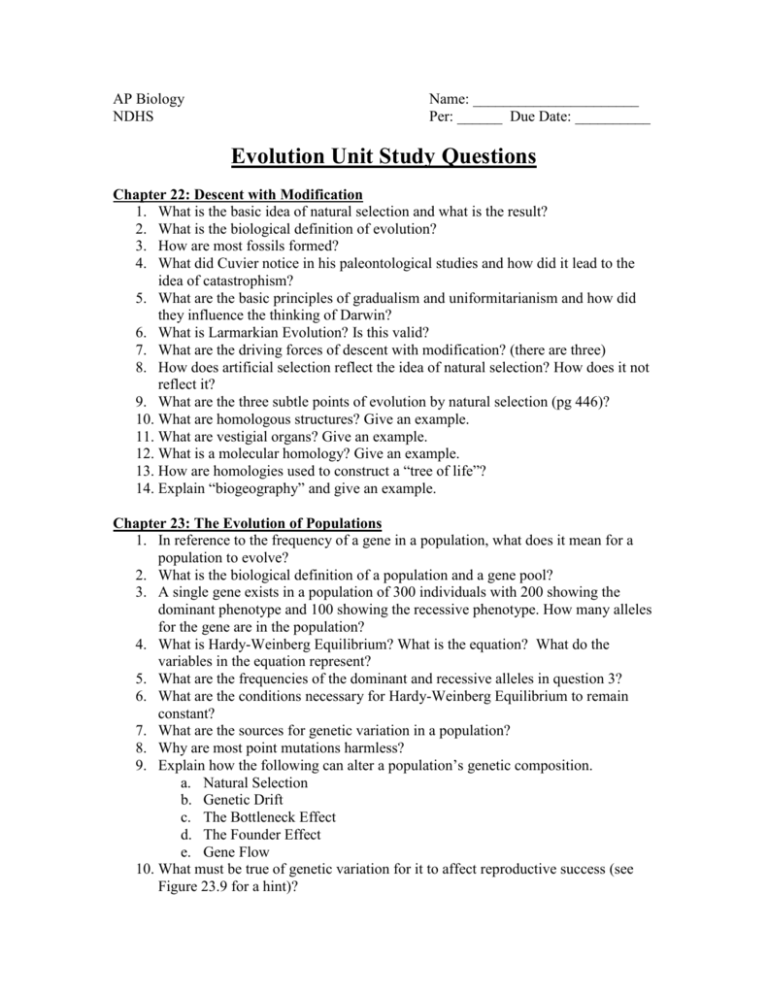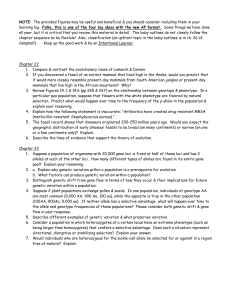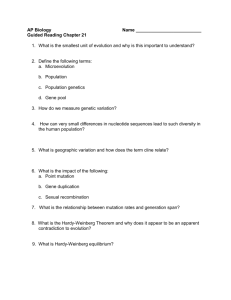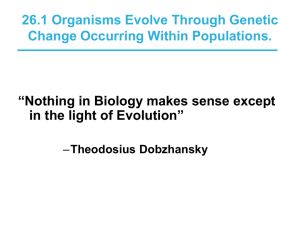File
advertisement

AP Biology NDHS Name: ______________________ Per: ______ Due Date: __________ Evolution Unit Study Questions Chapter 22: Descent with Modification 1. What is the basic idea of natural selection and what is the result? 2. What is the biological definition of evolution? 3. How are most fossils formed? 4. What did Cuvier notice in his paleontological studies and how did it lead to the idea of catastrophism? 5. What are the basic principles of gradualism and uniformitarianism and how did they influence the thinking of Darwin? 6. What is Larmarkian Evolution? Is this valid? 7. What are the driving forces of descent with modification? (there are three) 8. How does artificial selection reflect the idea of natural selection? How does it not reflect it? 9. What are the three subtle points of evolution by natural selection (pg 446)? 10. What are homologous structures? Give an example. 11. What are vestigial organs? Give an example. 12. What is a molecular homology? Give an example. 13. How are homologies used to construct a “tree of life”? 14. Explain “biogeography” and give an example. Chapter 23: The Evolution of Populations 1. In reference to the frequency of a gene in a population, what does it mean for a population to evolve? 2. What is the biological definition of a population and a gene pool? 3. A single gene exists in a population of 300 individuals with 200 showing the dominant phenotype and 100 showing the recessive phenotype. How many alleles for the gene are in the population? 4. What is Hardy-Weinberg Equilibrium? What is the equation? What do the variables in the equation represent? 5. What are the frequencies of the dominant and recessive alleles in question 3? 6. What are the conditions necessary for Hardy-Weinberg Equilibrium to remain constant? 7. What are the sources for genetic variation in a population? 8. Why are most point mutations harmless? 9. Explain how the following can alter a population’s genetic composition. a. Natural Selection b. Genetic Drift c. The Bottleneck Effect d. The Founder Effect e. Gene Flow 10. What must be true of genetic variation for it to affect reproductive success (see Figure 23.9 for a hint)? 11. How does phenotypic polymorphism differ from genetic polymorphism? 12. What percentage do two humans differ? 13. How does geography contribute to genetic variation? 14. What is “fitness”? Give three examples. 15. What is “relative fitness”? Provide one example. 16. What are the three basic types of selection? Give examples of each. 17. How is genetic variation in a population preserved? (pg 466-468) 18. Why is sex confusing to scientists? Why is it good (as a benefit to the survival to the species)? 19. Why doesn’t natural selection form perfect organisms? Chapter 24: The Origin of Species 1. Species are separated by reproductive barriers. These come in two forms: prezygotic and postzygotic. Differentiate between these two barriers. 2. What are the main prezygotic barriers? (just list don’t explain) 3. What are the main postzygotic barriers? (same thing as ↑) 4. What are the limitations of the biological species concept? 5. Differentiate between allopatric and sympatric speciation. 6. Does geographic isolation necessarily cause speciation? Explain. 7. How does an evolutionary novelty potentially lead to macroevolutionary change? 8. What are homeotic genes? How would a change in a homeotic gene affect speciation? Chapter 25: Phyolgeny and Systematics 1. What does the process of phylogenic systematics do? 2. How are phylogenic relationships constructed from morphological and molecular homologies? 3. How do analogous structures cause difficulty in the construction of phylogenic trees? 4. How does taxonomy relate to a phylogenic tree? 5. What is a molecular clock and how does it relate to the neutral theory? (page 506) Chapter 26: The Tree of Life: An Introduction to Biological Diversity 1. What is the basic sequence of the origin of life on the planet? (page 513) 2. What kind of atmosphere is necessary for the abiotic production of organic compounds? 3. What is molecular natural selection? (page 516) 4. Explain radiometric dating. 5. How did prokaryotes change the earth? (See photosynthesis and the Oxygen Revolution) 6. How did eukaryotes arise? 7. What is the endosymbiotic theory?









